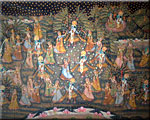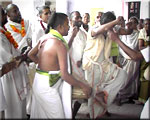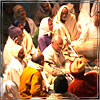-
Posts
1,517 -
Joined
-
Last visited
Content Type
Profiles
Forums
Downloads
Gallery
Events
Store
Posts posted by raga
-
-
Rasa-lila kirtana

Rasa-lila, the circle-dance of Krishna and his beloved gopis, is one of the most popular themes in lila-kirtana, songs depicting Krishna's pastimes. This series of eleven songs was recorded at the Rasabari temple at Radha-kunda. Lead kirtaniya: Anath Bandhu Das Babaji.
Total running time: 61:56 min
http://www.lakeofflowers.com/entry/rasa-lila
----
With this entry, Lake of Flowers Productions now offers a round grand total of 100.8 GB of media for free download.

-
You are of course free to behave like that. You may want to take a print-out of your post and give it to your guru, asking if he feels your words reflect proper Vaisnava conduct.
"...find me holding your collar" - "GOODBYE and GOOD RIDDANCE". Such words and feelings are born of tamas and rajas. They only serve to degrade you, diminishing your taste for the holy name.
Please do not impose aparadha on my post - I never said anything offensive of your guru. In fact, I did not comment on your post at all. I replied to the original post of the thread.
-
As noted, you must sublimate the energy gathered. If this is not done, the power turns against you. Though physical exercise is good, sound sadhana and a sattvic life-style is the best means of managing this. Some practices you may want to take up:
* Do extended periods of japa. Sit in a proper posture (padmasana, siddhasana, gomukhasana), do not whirl around. At least an hour or two daily. (1)
* When the body gathers heat, favor a diet that cools the body. Always drink enough water - at least two liters daily.
* Practice yoga-asanas that contribute both to celibacy and to general health – sirsasana and sarvangasana being among the most important.
* Stay aloof from asat-sanga – specifically, company and entertainment that deal with sexually provoking themes.
You may also find the gkWiki-article on Brahmacarya useful.
----
(1) If you find vacika-japa to be too intense (as I sometimes do), you may also do upamsu (quiet muttering) or manasika (mental) - I find that they generally allow for better inner concentration and also create less strain on the head and the vocal cords.
-
Never critisise anyone.See your faults and others Good and develop.the reverse will bring doom.Ego is the enemy of Bhakti. Kirtanta of Gods name brings Bhakti and Kirtana of others Faults will.......
With this, one should also be careful in thinking that others are criticizing or finding faults. It is quite possible that we have just misunderstood another, or we may even lack the adhikara for understanding another altogether.
Then, in our enthusiasm to avoid fault-finding and to eulogize the same, we have fallen into the pit of projecting (even in public!) this greatest of vices upon others -- what then will become of us? If undue fault-finding is the greatest obstacle to bhakti, and if we unjustly find the fault of fault-finding others, does that not pose the greatest obstacle to our devotion?
-
Please, I am dull. Could you explain where I have criticized anyone?
I was a member of ISKCON for many years. I do not think my answer conflicts ISKCON's teachings in any way. My ISKCON guru told me, "If you want to offer mentally, you must also eat only mentally."
If you want to quote the guide book verbatim, please do that.
-
<b>"Those who have chanted hari-nama for fifteen or twenty years should know such things.</b> The beginners need not hear these topics or they will misunderstand. These topics are for certain audiences, not for all.
---<i>Srila Bhaktisiddhanta Sarasvati Thakur</i>
I believe his idea was that it's for those who have changed for fifteen or twenty years, one lakh (64 rounds) daily. For those chanting 16 rounds, it would then read "<i>those who have chanted hari-nama for sixty or eighty years...</i>."

--
Regarding earlier comments on my posts, I'm disinclined to respond to guests who don't identify themselves.
-
Without raga we are simply empty shells following some mechanical process.
...
to say no raga is allowed is like saying "don't be attached, just perform your service like a robot".
Why, thank you! My self-inflated sense of importance was already beginning to wane.

Seriously though, there is much inclarity in definitions of raga-bhakti amidst all these considerations.
-
Again, as with the other question, this is a matter of whom you want to follow. You can have thousands of kinds of answers in a public forum, and pick and choose and make your own soup.
As a general principle, inner devotion and outer practice needn't be in conflict. The outher may become a ritual, and the inner may become non-existent as the mind slips and slides. The two complement each other.
-
What has been done here is ACBS's paraphrasing and commenting on a passage has been taken and placed as the translation. It is not meant to be a translation to begin with.
-
That is not a translation. That is a commentary. Not that I necessarily have any objections with the point itself.
-
Niyama-seva kirtana - Songs in the temples #4 (Video: 2005)

This is the fourth of a series of four compilations of songs from Niyama-seva. Kirtaniyas: Sanatana Das Babaji.
Part 4: Padavali-kirtana
1. Hari Hari Viphale Janama (SD) • 2. Bahuta Minati Koruto (SD) • 3. Sri Govinda Gopinatha (SD)
Total running time: 33:45 min
-
asato mā sad gamaya,
tamaso mā jyotir gamaya,
mṛityor māmṛitaṁ gamaya |
"Of the unreal not, for going to the real.
Of the darkness not, for coming to to the divine light.
Of the death not, for going to the immortality."
These three open a sacrifice, chanted by the sacrificial priest.
-
"Jiva Goswami says that one must try to find a genuine guru and ignore ecclesiastical, customary and social conventions."
Can someone please tell me where he says that?
-
I would suggest that you actually put the foods on a separate plate and bring it to an altar with a picture or murti of Sri Krishna and offer it there. If you are not diksita, you may just chant the maha-mantra and with a prayerful spirit ask for the Lord to partake of the meal. Then take his remnants. This is the most beneficial method from the angle of bhakti. You may or may not chant prayers before partaking of the meal -- that is secondary to the importance of directly offering it first.
As is evident by now, there are plenty of diverging traditions. You would then have to qualify the "we" in "mantra which we should chant" -- who are the "we", in which tradition?
-
The differences between ISKCON and any given other "Indian" group following Bhaktisiddhanta are substantially greater than the differences between the Indian groups. Therefore, a division between the two is befitting.
Why must we find ONE collective term to classify them? Because sometimes we need to collectively refer to them, but separate from ISKCON. I've also read and heard a great number of representatives of these different branches refer to themselves as "Gaudiya Math".
Then, I think this point is just a matter of wrangling, and I am not willing to engage in wrangling, especially not in Kripamoya ad-hoc style.
-
If "Gaudiya Math" is not a good collective term for lineages that grew from Bhaktisiddhanta's Gaudiya Math, what do you want us to call them? The Bhaktisiddhanta Bunch?
-
Vaidhi is for the purpose of getting those with no raga to awaken to raga. When the raga awakens, then vaidhi-bhakti holds the secondary position in the sadhana of the devotee.
You have invoked with devotion, and raga has awakened. Raga now prompts you to log in with your member account.
-
thank you for your comments. is there a generally recognized (in GV) "hierarchy of evidence"? as in for example: Vedas, Upanishads, Puranas, Itihasas, Agamas, works of the six Goswamis, previous recognized sampradaya gurus, current guru, etc. Many disciples of GV gurus nowadays accept instructions of their particular guru as the highest level of evidence, above any shastra. Is that justified in any way in our tradition?
Nothing etched in stone, really. There are diverging hierarchies for different genres of knowledge.
In classical ontological matters the hierarchy would be along the lines of Upanisads & Vedanta-sutra -> Gita and Puranas -> works of the Gosvamis etc. On the other hand, with doctrines and practices specific to our tradition, the hierarchy of authority begins with Sri Caitanya and the Gosvamis. As examples, we sometimes find the views of the earlier authors revised or contradicted in matters of rasa-tattva, and doctrines on praxis (such as are found in Hari-bhakti-vilasa) cannot really be said to be "established in compliance to" as much as they are "established while drawing from" diverse Puranas, Pancaratras and the larger body of tantra.
As the general principle within the sampradaya, authority is derived, it descends from up downwards. This is the meaning of parampara. There is little meaning for the word parampara if one is prepared to forsake all predecessors in favor of one's guru. If a guru demands such an attitude from the disciple, one should respect him from a distance and learn under the shelter of a siksa-guru who is realized and modest in his attitude.
-
It has been my understanding that in order to be a bonafide guru you must agree with sastra, so would it matter if one quotes the bonafide guru or sastra since both should be in accord?
You'll then invariably end with a situation where two bonafide gurus have diverging views. Then, people who hold the above assumption naturally conclude that the other person's guru is not bonafide, since yours is, and since bonafide gurus present only sastra. Practically, this is a very problematic approach.
If one intends to quote one's guru's views on sastra, one'd better know why his guru holds a particular interpratation of the sastra and how he arrived at that conclusion. If one cannot present the line of thought that led to a particular interpretation, one'd better not say it in public.
-
In a discussion or a dialogue, you can refer to any and all shared authorities in the capacity of evidence. Still, it is, of course, befitting to focus on the sastra, as sastra is the "original" authority. Doing that, you'll ensure the widest possible accepting exposure for what has been spoken. Non-shared authorities will either first have to be established as shared authorities (as Jiva Gosvami does with the Bhagavata in his Tattva-sandarbha), or otherwise quoted in a knick-knack capacity without resting one's points on them.
Deductive reasoning is a universal authority inasmuch as the premises of the rationale are accurate, and inductive reasoning will also generally pass if the leaps aren't massive. Precedents are authoritative inasmuch as accounts of them can be verified.
Then, addressing the original question: Given the above, it is generally appropriate to quote one's guru only among the godbrothers or in a similar environment, and moreover, even then generally only if a "higher level" evidence – the sastra – is not available, or when higher level evidences conflict (in which case the guru's rationale for accepting a particular view is also good to explain).
In inter-tradition debates, if neither of the participants is established in knowledge of scriptures with shared authority (such as the Puranas or the Upanisads), there is little to be gained from a debate where each cites his own tradition's interpretations as evidence – much like if a Christian were to cite the Bible for you. In such situations, the best mode of discussion is a dialogue in which both respectfully explore each others' heritages. That can, in fact, often be more beneficial than an attempt to be in a directly shared arena with a clash of interpretations.
-
Considering a conversion?
-
Niyama-seva kirtana - Songs in the temples #3 (Video: 2005)

This is the third of a series of four compilations of songs from Niyama-seva. Kirtaniyas: Sanatana Das Babaji, Visvambhara Das Babaji, Vinoda Das Babaji.
Part 3: In Praise of Radharani
Six Hindi songs in praise of Radharani. (Can someone help us out with the song titles, please?)
Total running time: 24:38 min
-
Was there or is there or will there be a right time to go over to the Gaudiya Math to take shelter?
The right time would be yesterday, or when the hell freezes over, or anything in between the two, depending largely on whom you ask. The question, then, comes down to whom you follow and whose view makes sense to you.
-
The zarIra avidya-jal is technically a pada, a piece of Bengali poetry. I can assure everyone it most certainly is not in Sanskrit, and the word mantra is not customarily used for the such, regardless of how one might explain the meaning of the word mantra.
In Vrindavan at festivals, Gaudiya Vaisnavas commonly chant a rather lengthy Jaya-dhvani before taking prasad. Then, there's another cute chant:
rAma kaha sukhe bhaje, kRSNa kaha duHkha yAYa |
mahA-prasAda pAo sAdhu, prema prIti lAgAi ||
“Say Rama and worship with joy, say Krishna and miseries flee.
O saints, take the most glorious prasad – prema and priti are available!”
That is in Bengali, too. One may also chant or remember any other songs or verses, such as the descriptions of Sri Caitanya Mahaprabhu's praising Jagannatha's maha-prasada in Caitanya-caritamrita, Antya-lila, chapter 16.


Wanna really know about someone's character?
in Spiritual Discussions
Posted
For example.
"Prabhus, never find fault in Vaishnavas. Just like that Krishna Das, he's such a fault-finder. Don't become like him!" (Followed by an innuendo on why Krishna Das is so bad because he's a fault-finder: Just see what fault-finding turned him into.)
That's an extreme example, but not uncommmon I find.
Then, you have the countless other cases where someone starts accusing another of being a fault-finder because of a misunderstanding. A rule of thumb, then, is to "always assume best intention".
Devotees in internet forums, especially those who feel they need to be on the defensive, often assume the worst and start blasting off others for being offensive, even if the original poster never meant any offense.
Another important rule is, "Ask to clarify before you state a conclusion about another." I cannot claim to be perfect in following all this myself, but I think it is important that everyone recognizes this in principle and tries to adjust their conduct accordingly.